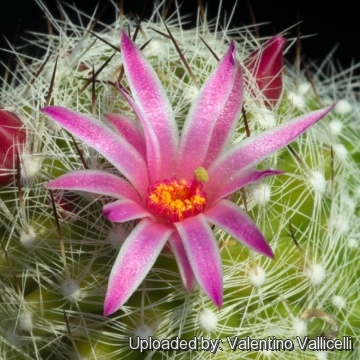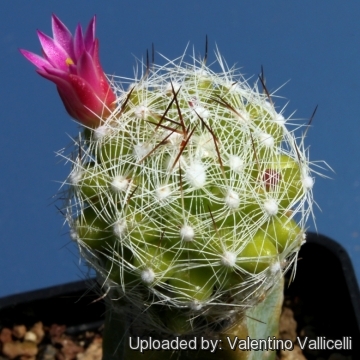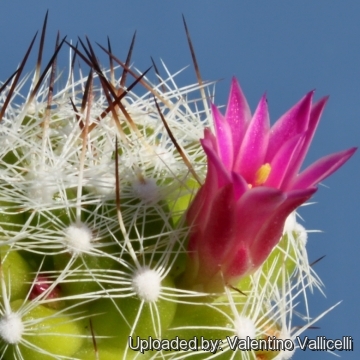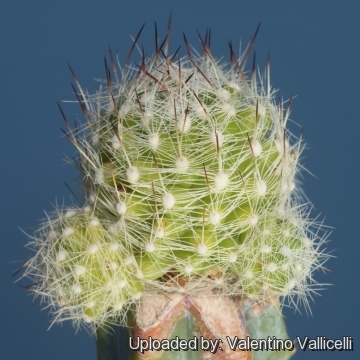Accepted Scientific Name: Mammillaria kraehenbuehlii (Krainz) Krainz
Kakteen Sukk. 22(5): 93 (May 1971). without basionym ref.; et in Kakteen,46-47: CVIIc (Junc 1971); also D.R. Hunt in J. Mammillaria Soc., 11 (5): 61(Oct. 1971)

Escobariopsis kraehenbuehlii (Mammillaria kraehenbuehlii) Photo by: Valentino Vallicelli
Origin and Habitat: Oaxaca, Mexico.
Synonyms:
Description: It is a clustering species with white spines on pale green bodies that form dense low clusters.
Stem: Globose to shortly cylindrical, soft, 3-12 cm tall, up to 3.5 cm in diameter.
Tubercles: Attenuate to conical, without latex, axils naked.
Central: 0-1 whitish with brown tips, 5-10 mm long.
Radial spines: 18-24, very thin, white with brown tips, curving and interlacing, 3-8 mm long.
Flowers: Lilac-carmine, up to 18 mm long.
Fruits: Carmine.
Seeds: Black.
 Escobariopsis kraehenbuehlii (Mammillaria kraehenbuehlii) Photo by: Valentino Vallicelli
Escobariopsis kraehenbuehlii (Mammillaria kraehenbuehlii) Photo by: Valentino Vallicelli Escobariopsis kraehenbuehlii (Mammillaria kraehenbuehlii) Photo by: Valentino Vallicelli
Escobariopsis kraehenbuehlii (Mammillaria kraehenbuehlii) Photo by: Valentino Vallicelli Escobariopsis kraehenbuehlii (Mammillaria kraehenbuehlii) Photo by: Valentino Vallicelli
Escobariopsis kraehenbuehlii (Mammillaria kraehenbuehlii) Photo by: Valentino Vallicelli Escobariopsis kraehenbuehlii (Mammillaria kraehenbuehlii) Photo by: Valentino Vallicelli
Escobariopsis kraehenbuehlii (Mammillaria kraehenbuehlii) Photo by: Valentino VallicelliCultivation and Propagation: Requires excellent drainage provided by porous cactus soil (With not less than 50% grit content). We suggest repotting every 2-3 years. Prefers bright light and ample airflow. Outside full sun or afternoon shade, inside it needs bright light, and some direct sun. Water should be carefully applied and only when the soil is dry to the touch, as fits this cliff-dwelling species. Allow soil to drain thoroughly before watering again. Do not water in the winter (Rot prone). Protect from frost. But it's hardy to -5°C if kept dry. During the beautiful season enrich the soil using a fertilizer rich in potassium and phosphorous, but poor in nitrogen, because this chemical element doesn’t help the development of succulent plants, making them too soft and full of water. This rarely found species is slow growing, but rewards the patient grower with displays of small dark pink flowers. Winter rest is important to stimulate flowering. Use small sized pots.
Propagation: Direct sow after last frost, cuttings or grafting.














